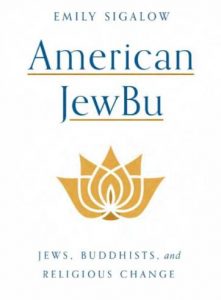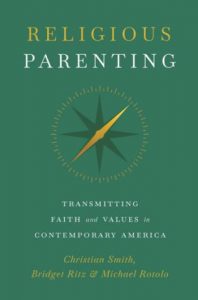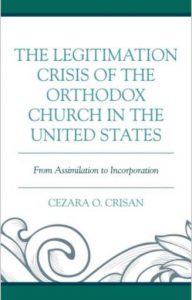
![]() American JewBu (Princeton University Press, $29.95) by Emily Sigalow, is both a history and sociological study of the phenomenon of Jews converting to or simultaneously practicing Buddhism. The book is also one of a growing number of works that explores the growth of religious syncretism or at least “dual religion” in the West, where once this pattern was most evident in Eastern societies. The history of Jewish involvement and interest in Buddhism stretches back over a century in the U.S. and such borrowing and fascination has not only been a one-way affair. Sigalow writes that the Jewish adaptation of Buddhism, starting with intellectuals
American JewBu (Princeton University Press, $29.95) by Emily Sigalow, is both a history and sociological study of the phenomenon of Jews converting to or simultaneously practicing Buddhism. The book is also one of a growing number of works that explores the growth of religious syncretism or at least “dual religion” in the West, where once this pattern was most evident in Eastern societies. The history of Jewish involvement and interest in Buddhism stretches back over a century in the U.S. and such borrowing and fascination has not only been a one-way affair. Sigalow writes that the Jewish adaptation of Buddhism, starting with intellectuals  practicing Zen over a century ago, has had the effect of secularizing Buddhism of its distinctive religious traditions (stressing meditation over rituals) while reviving spirituality in American Judaism. The unique minority position of Jews, making them the first large non-Christian immigrant population in the U.S. facilitated much of this interchange. Buddhism’s remove from the Jewish-Catholic-Protestant establishment appealed to liberal Jews as well as to other later countercultural intellectuals, but Buddhism has since moved from the “left periphery” and gained wider acceptance among Jewish Americans, mainly through its mindfulness practices and “medicalization” (seeing meditation as healthy). Sigalow adds that another possible reason for the Jewish-Buddhist affinity may be that the structural openness of Buddhist centers allowed for those of other persuasions to participate without feeling they must choose between one or the other affiliation.
practicing Zen over a century ago, has had the effect of secularizing Buddhism of its distinctive religious traditions (stressing meditation over rituals) while reviving spirituality in American Judaism. The unique minority position of Jews, making them the first large non-Christian immigrant population in the U.S. facilitated much of this interchange. Buddhism’s remove from the Jewish-Catholic-Protestant establishment appealed to liberal Jews as well as to other later countercultural intellectuals, but Buddhism has since moved from the “left periphery” and gained wider acceptance among Jewish Americans, mainly through its mindfulness practices and “medicalization” (seeing meditation as healthy). Sigalow adds that another possible reason for the Jewish-Buddhist affinity may be that the structural openness of Buddhist centers allowed for those of other persuasions to participate without feeling they must choose between one or the other affiliation.
As Jews increasingly fill the ranks of Buddhist centers and teachers, such an accumulating presence has made these institutions and leadership positions more appealing and welcoming to other Jewish practitioners. Through interviews, Sigalow finds that Jews involved in Buddhism are largely divided between those whose primary religious-spiritual identity is Buddhist even as they retain a Jewish ethnic identity and those who use Buddhist practices to support a Jewish religious identity. The syncretistic concept and label of a “JewBu” identity is welcomed by younger generations, seeing the “identity as a way of staking out a progressive and sometimes even radical social position further to the left of the mainstream American Jewish community.” Older Jewish Buddhist practitioners tend to reject the label, seeing it as shortchanging both identities. Sigalow concludes that just as Jews changed the non-ethnic American Buddhist community, the younger JewBus, especially those from Asian-Jewish families and marriages, may bring new changes to Judaism. “Perhaps the next period of Jewish-Buddhist encounter in the United States will be one in which Jews take an interest in Buddhism and Buddhists take an interest in Judaism, and the result of these crossovers are new creative Jewish Buddhist and Buddhist Jewish outcomes,” Sigalow concludes.
![]() Although religious socialization is often seen as major factor in secularization and religious vitality, there has not been much research on the role of religious parenting (though more on children) in such outcomes, something the new book Religious Parenting
Although religious socialization is often seen as major factor in secularization and religious vitality, there has not been much research on the role of religious parenting (though more on children) in such outcomes, something the new book Religious Parenting  (Princeton University Press, $35) attempts to remedy. The book, by Christian Smith, Bridget Ritz, and Michael Rotolo, looks at the various parenting strategies, practices, and beliefs across the religious spectrum. Based on a national survey of 235 religious and non-religious parents, the book focuses on the 215 self-identified religious participants. The study tends to find more similarity than differences among parents on the importance of transmitting their particular faith, but there was also more moderation on a didactic approach to keeping children in the faith (black Protestants are the exception here). The one thing most agreed on was their concern about their children moving to an “extremist” and “fanatical” religion. Immigrant and conservative religious parents did show more concern about their children leaving their faiths, but Smith, Ritz, and Rotolo generally found a strong this-worldly orientation—religion as promoting family-togetherness and helping children to lead a better and more fulfilling life—rather than a concern with salvation and life after death among most parents (again, conservative Protestants being the exception).
(Princeton University Press, $35) attempts to remedy. The book, by Christian Smith, Bridget Ritz, and Michael Rotolo, looks at the various parenting strategies, practices, and beliefs across the religious spectrum. Based on a national survey of 235 religious and non-religious parents, the book focuses on the 215 self-identified religious participants. The study tends to find more similarity than differences among parents on the importance of transmitting their particular faith, but there was also more moderation on a didactic approach to keeping children in the faith (black Protestants are the exception here). The one thing most agreed on was their concern about their children moving to an “extremist” and “fanatical” religion. Immigrant and conservative religious parents did show more concern about their children leaving their faiths, but Smith, Ritz, and Rotolo generally found a strong this-worldly orientation—religion as promoting family-togetherness and helping children to lead a better and more fulfilling life—rather than a concern with salvation and life after death among most parents (again, conservative Protestants being the exception).
The pragmatic tone of the parents carried over into their attitudes toward the authority of their respective religions. The Catholic parents were among the most individualistic, feeling authorized to question and decide beliefs of their tradition, while Jews and Muslims felt little conflict with their religions. The authors conclude that most of the religious parents tend to see the transmission of their faiths to their children through a framework of a “this-worldly resource.” This is where religion is valued for its practical ability to help with life problems and relationships and to foster “values” rather than with maintaining distinctive beliefs and traditions. Smith’s previous formulation of the belief system of young people (known as Moral Therapeutic Deism) is clearly in play among these parents. It was also found that these parents see religious socialization as a “family project” rather than a more communal endeavor in partnership with congregations, religious education, and youth workers.
![]()
 The popular image of Pagans engaged in group rituals and magic is debunked in Helen Berger’s new book Solitary Pagans (University of South Carolina Press, $34.99), as she finds a growing number of solo practitioners. Berger bases much of the book on a “Pagan Census,” where she surveys Pagan practitioners about their beliefs and practices (this is an online survey of 6,000 U.S. pagans and is not a random sample). She notes that the percentage of solitary practitioners has grown from just over 50 percent in her first census to 78 percent in her most recent survey. Berger argues that while it may be true that contemporary Pagans (or Neopagans) have embraced religious individualism, they are far from socially isolated (even if they have fewer ties to those who work in groups, they still attend festivals and participate in social media networks) or politically uninvolved. In fact, while solitary Pagans are less politically involved than those involved in group practice, they are still more active than most other Americans. Berger’s findings cover wider ground than the group and solitary dynamics of paganism. She writes that the main factor in the rise of solitary Paganism was the overall increase and diversification in Pagan interest and involvement overall, and much of this is mediated through the Internet, which suits individual-based religion and spirituality.
The popular image of Pagans engaged in group rituals and magic is debunked in Helen Berger’s new book Solitary Pagans (University of South Carolina Press, $34.99), as she finds a growing number of solo practitioners. Berger bases much of the book on a “Pagan Census,” where she surveys Pagan practitioners about their beliefs and practices (this is an online survey of 6,000 U.S. pagans and is not a random sample). She notes that the percentage of solitary practitioners has grown from just over 50 percent in her first census to 78 percent in her most recent survey. Berger argues that while it may be true that contemporary Pagans (or Neopagans) have embraced religious individualism, they are far from socially isolated (even if they have fewer ties to those who work in groups, they still attend festivals and participate in social media networks) or politically uninvolved. In fact, while solitary Pagans are less politically involved than those involved in group practice, they are still more active than most other Americans. Berger’s findings cover wider ground than the group and solitary dynamics of paganism. She writes that the main factor in the rise of solitary Paganism was the overall increase and diversification in Pagan interest and involvement overall, and much of this is mediated through the Internet, which suits individual-based religion and spirituality.
But there is not much of a difference in the kinds of Pagan beliefs and practices according to whether practitioners embrace a group or solitary style (although the majority consider themselves “goddess worshippers,” “wiccans” and “witches.”) Paganism (especially the solitary kind) is attracting a younger following, much of it based on entertainment media such as on teen witches, as well as Internet involvement. In fact, younger practitioners make up 36 percent of Berger’s U.S. sample, while baby boomers comprise 34 percent. Other changes that Berger found since her first census is a growth of non-tech and STEM professions among Pagans; still largely female (71.6 percent) and growing in that regard; contemporary Pagans are more rural-based than the rest of Americans (though most are still urban and suburban); right-wing Pagans are still a small minority (about one percent), although such a group as the Heathens (stressing European ethnic roots and not all racialist) are attracting among the youngest people to their ranks. Berger concludes that Paganism is a disorganized religion, but she differs from secularization theorists, who see such a diffuse movement with fuzzy boundaries as lacking social and moral influence and headed for extinction. Rather, she argues that Pagans do have boundaries, even if they are weaker than other religions, and show a set of ethics that is largely women-based and concerned with “caring and connecting.”
![]() The ways that different interests and needs of older assimilated members, a newer wave of immigrants from the post-Soviet Union, and converts to Eastern Orthodoxy in America conflict in this venerable Christian tradition is the subject of the new book, The Legitimation Crisis of the Orthodox Church in the United States (Lexington Books, $80). Author Cezara O. Crisan, a sociologist from Purdue University, refers to the “crisis” in the Orthodox churches as relating to the way that the various parties have different
The ways that different interests and needs of older assimilated members, a newer wave of immigrants from the post-Soviet Union, and converts to Eastern Orthodoxy in America conflict in this venerable Christian tradition is the subject of the new book, The Legitimation Crisis of the Orthodox Church in the United States (Lexington Books, $80). Author Cezara O. Crisan, a sociologist from Purdue University, refers to the “crisis” in the Orthodox churches as relating to the way that the various parties have different  expectations and visions of the church that often hampers its broader ministry and role in society. Crisan bases her research on an ethnographic study of Orthodox parishes in the Midwest along with an analysis of a national study of Eastern Orthodox immigrant churches. The sociologist focuses on the distinctive nature of the newer immigration from Eastern Europe and the former Soviet Union largely in the non-ethnic Orthodox Church in America (OCA), where she finds (along with other immigrants) transnational identities take precedent over the older model of assimilation (other more ethnic Orthodox bodies, such as the Greek Orthodox Church and the Antiochian Orthodox Archdiocese are not included in this study). These immigrants tend to favor older ethnic traditions—many of which have been discarded by Orthodox parishes—and distance themselves from participation in the democratic decision-making process in these churches.
expectations and visions of the church that often hampers its broader ministry and role in society. Crisan bases her research on an ethnographic study of Orthodox parishes in the Midwest along with an analysis of a national study of Eastern Orthodox immigrant churches. The sociologist focuses on the distinctive nature of the newer immigration from Eastern Europe and the former Soviet Union largely in the non-ethnic Orthodox Church in America (OCA), where she finds (along with other immigrants) transnational identities take precedent over the older model of assimilation (other more ethnic Orthodox bodies, such as the Greek Orthodox Church and the Antiochian Orthodox Archdiocese are not included in this study). These immigrants tend to favor older ethnic traditions—many of which have been discarded by Orthodox parishes—and distance themselves from participation in the democratic decision-making process in these churches.
Through interviews, Crisan finds that these immigrants don’t feel that these Americanized parishes offer the traditions and help they need to pass on the faith (and ethnic traditions) to their children. But because influxes of newer ethnic members are still needed to financially sustain parishes, their influence can also prevent needed reforms and the evangelizing of American society, which frustrates priests and bishops (many of whom are converts) as they seek to minister to everybody in the parish. While Eastern Orthodoxy has become attractive to non-ethnic Americans for its spirituality and practices in recent years, Crisan argues that these converts, who tend to have more in common with the older, assimilated members as they de-emphasize ethnic belonging, may also be discouraged in these ethnically dominated parishes. As long as these competing interests and needs are unmet not addressed by the church, this “crisis of legitimacy” will persist and may even intensify in Eastern Orthodox churches in the U.S. as nationalism grows at home and abroad, Crisan concludes.

![]() Japan’s “hidden Christians” who went into seclusion during three centuries of persecution, managed to retain an amalgam of Christian practices, beliefs, and artifacts through familial devotion and transmission up to the present day, even as Christianity became legal and a segment of practitioners joined established churches. But that effort to preserve the hidden Christian identity is faltering due to the loss of communal ties, writes Kirk Sandvig in his new book Hidden Christians in Japan (Lexington Books, $90). In recent years communities of hidden Christians in remote parts of Japan have disbanded, leading Sandvig to focus on the bleak prospects of their influence continuing. The author looks at Hidden Christian communities on the islands of Goto and Ikitsuki where Hidden Christian practices are on the verge of imminent demise. The Japanese practice of ancestor veneration most strongly seen among Buddhist and Shinto adherents has been adopted by hidden Christian communities, though directed toward Christian martyrs who faced persecution.
Japan’s “hidden Christians” who went into seclusion during three centuries of persecution, managed to retain an amalgam of Christian practices, beliefs, and artifacts through familial devotion and transmission up to the present day, even as Christianity became legal and a segment of practitioners joined established churches. But that effort to preserve the hidden Christian identity is faltering due to the loss of communal ties, writes Kirk Sandvig in his new book Hidden Christians in Japan (Lexington Books, $90). In recent years communities of hidden Christians in remote parts of Japan have disbanded, leading Sandvig to focus on the bleak prospects of their influence continuing. The author looks at Hidden Christian communities on the islands of Goto and Ikitsuki where Hidden Christian practices are on the verge of imminent demise. The Japanese practice of ancestor veneration most strongly seen among Buddhist and Shinto adherents has been adopted by hidden Christian communities, though directed toward Christian martyrs who faced persecution.
Even if distinct Christian beliefs had faded, family rituals helped perpetuated these communities up until recently, with the growth of tourism and the display of artifacts (images of saints, Mary, and Jesus) in museums giving public recognition to the hidden Christians. But the shift in the multi-generational household structure of hidden Christian families, with members living apart to a greater extent, younger people migrating to the cities, and the growth of intermarriage is further dissolving these communities, a process ironically intensified due to the tourism surrounding hidden Christian sites. Sandvig concludes that hidden Christians have increasingly taken up an amalgam of Buddhist and Shinto practices (with parents now preferring to teach their children only those observances), with the meanings behind Christian rituals largely fading. The solution of joining the Catholic Church (which is most similar to hidden Christian’s beliefs and practices) has been taken up by some hidden Christians, but others resist the exclusive nature of Catholicism and rather tend to transfer their beliefs and practices to other religions.